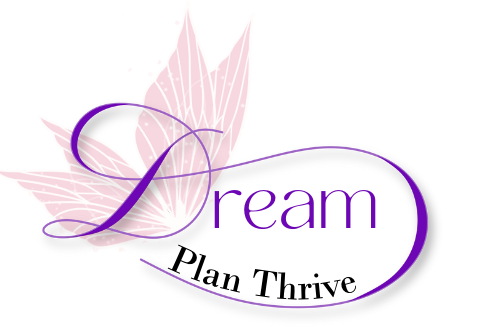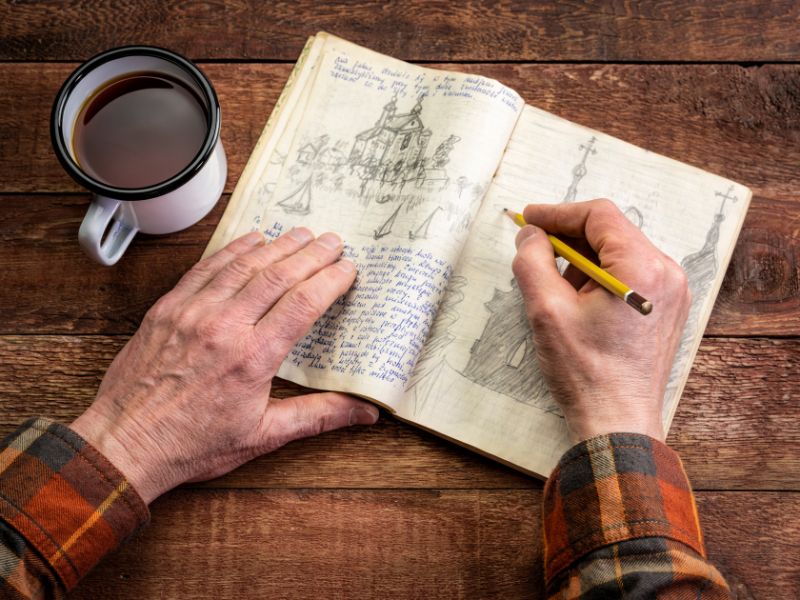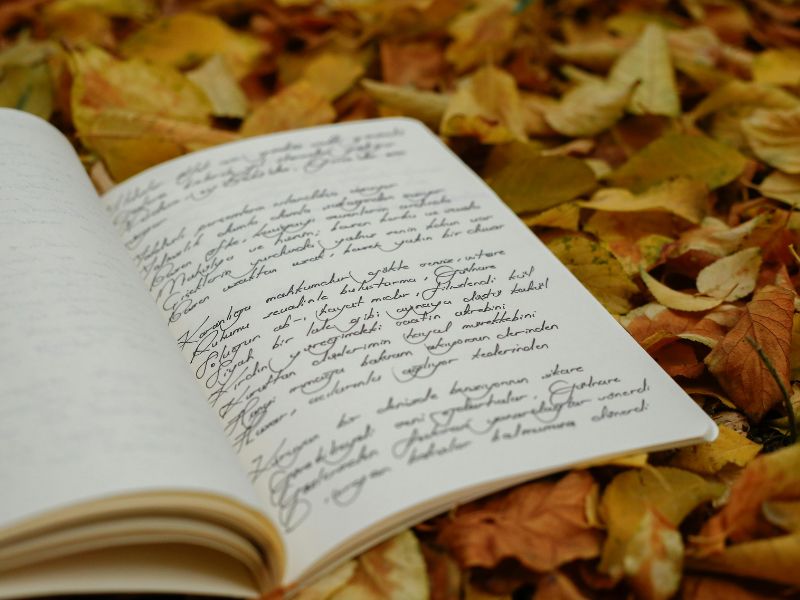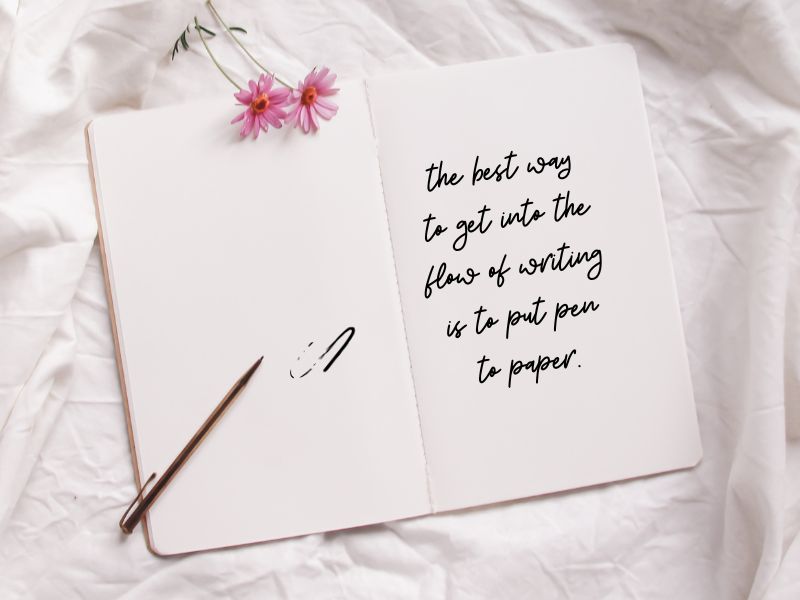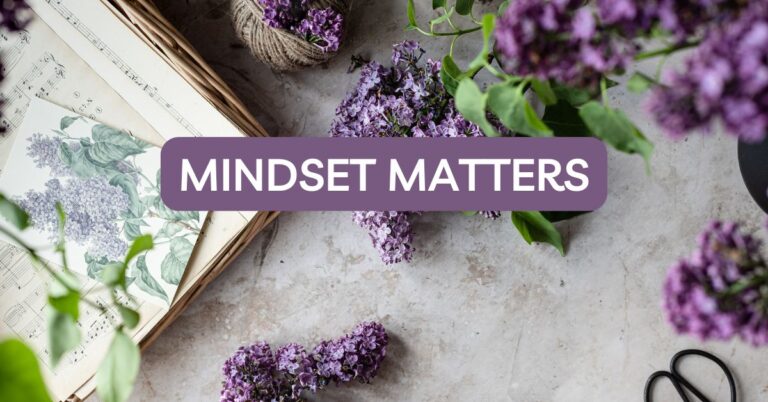
There’s something special about writing with a pen. Some people love how the pen moves across the paper, the feel of the sheets, and watching their thoughts fill each page. Typing, on the other hand, often feels less personal. It’s usually faster and requires less thought. Writing by hand can give your busy mind a break. The slower pace helps you think and plan before you start typing. This way, you avoid just pressing keys without really thinking about what you’re saying.
There’s a good amount of people eager to indulge in writing, and they won’t have problems doing so. There is evidence that states writing improves the brain’s memory, retention, and creativity because it activates diverse parts of the brain. Nostalgia on its own is not the sole motive behind its benefits, as neuroscience aids in promoting the importance of handwriting.
This post contains affiliate links, which means I may receive a small commission, at no cost to you, if you make a purchase through a link. Read the full disclosure here.
Benefits of Actual Handwriting
Writing can be beneficial to those looking to heal emotionally, to capture memories, or even to people who struggle with their communication skills. Undoubtedly, every individual has their own set of journaling methods. However, placing a pen onto paper brings countless benefits. A few noteworthy reasons are listed below.
With each passing day, the world of technology grows at an exponential pace. We are all at a point where we multitask like it’s second nature. Writing employs a much more rigid approach, as it necessitates greater patience to ensure accuracy. Rushing is simply not an option, and only in such a way can one be able to form cohesive letters. Unfortunately, thoughts and movements must ‘sync up together,’ and this is a much slower process for many. This rate of speed promotes low levels of stress.
Alleviating Stress: The ability to focus on one’s mental and emotional state allows for a greater degree of calm focus. When one is able to take a breather, mental health can greatly improve.
Improved Self-Reflection: By being devoid of pesky notifications, one’s inner self becomes easily accessible.
Better Memory Retention
Time and time again, studies have shown that note-taking yields a greater ability to recall information. The pencil-and-paper method of note-keeping is greatly relied on by teachers. There’s a reason for this.
Writing Proficiency: Just about everyone possesses the ability to write, meaning skills, mental activity, and cognition form at the same time.
Deeper Processing: While typing can be an exercise in muscle memory, writing helps you process your thoughts as it slows you down.
Enhances Creativity and Clarity
Many people find freedom in writing by hand, liberating their creative potential. Think of it as the difference between painting on a canvas and coloring on a tablet. While both are beneficial, only the former is organic and incorporates touch.
Unleashing Creative Ideas: When away from social media, chat notifications, and emails, your mind can drift, which often gives rise to creative ideas.
Organized Thought Flow: Having the ability to scribble gives clarity to tangled emotions or complicated concepts, enabling you to discover patterns or answers that would otherwise go unnoticed.
Deep Emotional Connection
There is something deeply intimate about writing by hand. Every swirl or slant of your letters represents your sense of self, your mood, and your unique style.
Authentic Self-Expression: Unlike typed text, which is uniform, your handwriting is as unique as your voice, allowing for true self-expression.
Powerful Nostalgia: Seeing your own handwriting in old journals evokes garish memories, allowing the passage of time to become emotional.
Less Screen Time
We all know the damage that excessive screen time does to us, and this is something that can easily be fixed. Thankfully, sticking to your pen and paper allows you to take a break and relax your eyes and mind.
Decreased Blue Light Exposure: Alleviating your eye symptoms, which stem from overstrain, has its own cumulative benefits, which improve your overall health.
Self-Care: Taking a break from your gadgets and indulging in an analog ritual increases your overall productivity while nurturing your mental health.
Venting and Emotional Release—Especially When Angry
Writing under rage or excessive frustration is an innovative method that is often overlooked and goes unnoticed; however, it does have some vital mental benefits. We all know that when you are extremely angry, expressing your feelings and emotions can be really challenging. Instead, you can consider writing them down on paper.
Blunt Release: Begin scribbling down your thoughts, allowing your emotions to completely pour out onto the paper without thinking about anything else.
Soft Landing: By writing down your angry thoughts, you are able to express yourself, making the feelings of anger dissipate.
Types of Journals that Help Gain Awareness
Motives are unique to each individual, so journals can have different forms. A variety of styles that you might merge with your personality, goals, or situation are provided below.
Daily Gratitude Journal
Writing down three to five things you are grateful for a day or cultivating positivity is what this daily practice focuses on.
- Mindful Reflection: Having to write your gratitude list helps put things in perspective and properly reflect on every item.
- Example: “I am grateful for the sunshine that brightened my morning walk. Not only did it lift my spirits while energizing me, but it also got me ready for the rest of the day.”
Bullet Journal
Having a system for planning, setting goals, and reflecting on progress all ties into bullet journaling. This form of journaling is ideal for reflection on oneself.
Various forms of data can be collected through bullet journals and include mood tracking, weekly and monthly spreads, and meal planning.
For those who perform exceptionally well under guidelines but like to bring in their creativity, bullet journals are the best go-to.
Travel Journal
Journals packed with ticket stubs, sketches, and anecdotes you can read when you come home are the best. Remembering your best moments stored in a journal is extraordinary.
As you travel, some foreign elements are foods, sounds, and even the local paper. Being able to describe all these sensations enriches your memories like nothing else.
Suggested Practice: “Every single day, write down your travel experiences. Do this while the memories are fresh and you are still in the environment.”
Dream Journal
To bring thoughts to mind, you can keep a notebook by the bed, so whenever you wake up, you have something beside you. Dreams are difficult to retain, especially once consciousness kicks in, so it’s always best to jot things down as soon as possible.
- Spark Creativity: Dreams can offer a variety of different ideas that serve as an excellent foundation for constructing stories, creating art, or even solving issues.
- Self-Discovery: Focusing on recurring themes within dreams can assist in unveiling desires, fears, or concerns one holds in their subconscious.
Art Journal or Visual Journal
This type of journal accepts doodles or sketches and collages to go along with the words on a page.
- Therapeutic expression: Those who are visually creative can find drawing their emotions to be as beneficial as writing down their thoughts.
- Personal Touch: There is something special about physically turning pages to pieces that are fully crafted around your words and emotions that is motivational.
Reflection or Therapy Journal
A reflection journal allows one to express anxiety, depression, or stress in a private and personal manner.
- Guided or Freeform: Some people use prompts from therapy or self-help books; others let their minds wander.
- Example: “Had a difficult conversation with a coworker today. I realize I could have approached it with more empathy. Note to self: work on active listening.”
Writing Prompts or Starter Ideas
If you’re new to journaling or feeling a bit stuck, trying to remember what to write about can be overwhelming, and prompts can help get rid of this writer’s block. Here are some examples of statements that can help you:
“What are you most looking forward to this week?”
Think about excitement or hope revolving around your goal.
“Describe a moment of joy or peace you experienced recently.”
A recent uplifting moment where your spirits were high can be relived in detail.
“List three lessons you learned last month.”
An experience from the past month that allows you to reflect and continue self-growth.
“Write a letter to your future self.”
Pick a goal, fear, or words of affirmation that allow you to achieve your ambitions.
“Draw or describe your surroundings right now and how they make you feel.”
Try closing your eyes and opening all five senses for a brief moment.
Additional Prompts for Specific Situations
Anger: “What exactly triggered this anger, and how can I process it in a more constructive way?”
For Imagination: “Write a short dialogue in which you have found an alien with many questions regarding the Earth and your conversation with the alien.”
Thankfulness: “Who helped me in an unexpected way recently, and what did this mean for me?”
What is your starting point?
There is no need to overthink this. You only need to grab a piece of paper and write according to your interest and intent.
Choose a Journal That Appeals to You
- The quality and aesthetics of the journal: Should it be leather-bound, spiral, dotted, or lined? Pick the format that feels appropriate in your hands.
- Large or small: If you are always on the move, a pocket-sized notebook is crafted for you. Alternatively, a large journal works well when at home.
Try Pens and Other Optional Personal Items
- Pick your favorite pen: The comfortable weight and smooth glide of a simple pen make writing a true pleasure.
- Use stickers or washi tape: Decoration can be motivational and appealing, drawing you to open your journal each day.
Establish a Routine
- Consistency is Key: This is the part that may vary; some like to jot down their ideas first thing in the morning or during the lunch break. The only wrong way is to do it to escape boredom because soon there will be no interest left.
- Pair It With a Ritual: Incorporate lighting a candle, brewing a cup of tea, or playing soft background music. These simple acts will make journaling effortless.
Keep It Accessible
Keep a small journal in your bag or on your desk for impromptu thoughts or bursts of emotion.
Overcome Common Objections
It’s perfectly fine to have concerns around journaling. Take a look at some of the objections people voice and suggestions for overcoming them.
“I Have Terrible Handwriting.”
Self-Expression, Not Calligraphy: Remember, your journal is not for a public display. Your journal is a very private space where what is written is more important than how it is written.
Progress Over Perfection: With time, your terrible handwriting might improve on its own. But even if it doesn’t, so long as the words come out, you are good to go.
“I Don’t Have Time.”
Micro-Sessions: Journaling is not a task that has to take up 30 minutes of your time. Even 5 minutes before going to bed could make a world of difference.
Prioritization: Treat journaling as self-care. If 5 to 10 minutes to write is permissible after indulging in social media, then there is always time to spare.
“Typing Is Faster.”
Handwriting is slower than typing, so many people assume typing is better. But handwriting’s slower pace offers a big advantage: time to think more deeply and remember more. This focused, tactile process helps the brain fully engage in ways that fast typing simply cannot match.
Deeper Reflection: This encourages vital engagement with thoughts in greater depth due to slowing you down, thus improving memory and aiding in emotional processing.
“I Have Nothing to Write.”
Prompts: Keep a list of journaling prompts handy so you always have ideas, or use a journal with prompts already included.
Daily Life: Let your life write for you. Record your daily experiences, feelings, and random thoughts. Keep it simple.
Real Life Journaling: Inspirations and Examples
Perhaps you’re curious about what an actual journal entry looks like. Or what’s the difference between different journaling approaches? The examples below show different approaches to journaling, illustrating how you could integrate them into your daily life.
Gratitude Journal
“I truly appreciate the mood-lifting sunshine on my morning walk. It made my walk quite enjoyable and set me up for the day ahead.”
“I feel grateful for the friends that allowed me to express what was troubling my mind. Their support made me feel understood, and I am thankful for that.”
Reflections on Daily Events
“Today, I had a tough chat with a colleague. I know now that I could have dealt with things in a more compassionate manner. Reminder to me: Soften my ears and open my heart.”
“Participated in a marvelous lecture on astrophysics. It fueled my interest in the subject again and motivated me to do more of my own research.”
Creative Writing Exercises
“Wrote a short, fun story today about a detective who travels through time. I enjoyed trying to think of different character motivations and plot twists.”
“This evening, I decided to try my hand at poetry. Playing with words and their meanings allowed me to be open about feelings I’ve had trouble expressing.”
Goal Setting and Progress Tracking
“Today I decided to work out for at least 30 minutes each day. I am happy to report that today marks one week of consistent exercise. My motivation is getting stronger and stronger.”
“Detailed my career goals for the next five years. It feels better to break them down into manageable portions that are easy to complete.”
Emotional Processing
“Feeling nervous, stressed, and overwhelmed about a presentation I have to give in the near future.”
“I logged my thoughts, which enabled me to pinpoint specific concerns.”
“Setbacks for me today. I’m letting the sadness pour in because I know that’s not only okay but completely normal.”
Brainstorming and Idea Generation
“I couldn’t help but notice the number of amazing businesses out there while on the bus. I cannot wait to dig in deeper.”
“Tackled an issue that happens enough at my job to be irritating, but not enough to do anything super drastic about. Even the dumbest ideas need to be listed; they might inspire better ones.”
Daily Observations and Insights
“Always look forward to the warmer days when they come around. They boost my mood no end.”
“Had to smile today because the wait isn’t even the worst part. The toughest part about these tasks is getting started.”
From Life, Feelings, to Goals: Three Dimensions of Journaling
Perhaps you’re curious about what an actual journal entry looks like. Or what’s the difference between different journaling approaches? The examples below show different approaches to journaling, illustrating how you could integrate them into your daily life.
Gratitude Journal
“I truly appreciate the mood-lifting sunshine on my morning walk. It made my walk quite enjoyable and set me up for the day ahead.”
“I feel grateful for the friends that allowed me to express what was troubling my mind. Their support made me feel understood, and I am thankful for that.”
Reflections on Daily Events
“Today, I had a tough chat with a colleague. I know now that I could have dealt with things in a more compassionate manner. Reminder to me: Soften my ears and open my heart.”
“Participated in a marvelous lecture on astrophysics. It fueled my interest in the subject again and motivated me to do more of my own research.”
Creative Writing Exercises
“Wrote a short, fun story today about a detective who travels through time. I enjoyed trying to think of different character motivations and plot twists.”
“This evening, I decided to try my hand at poetry. Playing with words and their meanings allowed me to be open about feelings I’ve had trouble expressing.”
Goal Setting and Progress Tracking
“Today I decided to work out for at least 30 minutes each day. I am happy to report that today marks one week of consistent exercise. My motivation is getting stronger and stronger.”
“Detailed my career goals for the next five years. It feels better to break them down into manageable portions that are easy to complete.”
Emotional Processing
“Feeling nervous, stressed, and overwhelmed about a presentation I have to give in the near future.”
“Setbacks for me today. I’m letting the sadness pour in because I know that’s not only okay but completely normal.”
Brainstorming and Idea Generation
“I couldn’t help but notice the number of amazing businesses out there while on the bus. I cannot wait to dig in deeper.”
“Tackled an issue that happens enough at my job to be irritating, but not enough to do anything super drastic about. Even the dumbest ideas need to be listed; they might inspire better ones.”
Daily Observations and Insights
“Always look forward to the warmer days when they come around. They boost my mood no end.”
“Had to smile today because the wait isn’t even the worst part. The toughest part about these tasks is getting started.”
Take That First Step
Well, if you get an urge to start journaling, this should be your sign. Grab a notebook and a pen and write without overthinking. Initially, it may be challenging, especially for someone who has not written by hand, but you must try to get past that first wall. Eventually, you will realize that journaling triggers a form of inner self-reflection where thoughts bloom, self-understanding grows, and frustrations get released.
Only You Can Set The Rules
You need to remember that the journal is your private space. There is no set procedure of how or what to write. You may be angry and want to let it all out, or you may have a perfect heartbreak you want to write about, or you may have a business idea you want to note, or you may simply want to track your workouts and nutrition. Some days call for ambitious filled pages, others for doodles of flowers, and some lines about the weather. Whatever you may want to write, it will never be wrong because it is yours.
Looking Back, Looking Forward
One of the simple pleasures of journaling is going over old entries. You most likely notice improvements and how you faced difficulties throughout your day-to-day life. These written records are reminders of how strong, perseverant, and self-reliant you have grown. Ultimately, they are statements of how much self-change and discovery can transform a person.
“Writing, to me, is simply thinking through my fingers.” – Isaac Asimov
Your own experiences, such as feeling shy or overlooked, can be powerful motivators for a change.
From mindfulness to emotional release, journaling can transform how you perceive and engage with your inner self.
Having poor handwriting or being short on time shouldn’t cancel out the value of journaling; it’s simply about finding ways to make it possible, even integrating it in small ways.
Journaling is an opportunity to slow down to listen, be creative, and heal. A notebook and pen can be helpful whether looking for an emotional outlet, documenting daily life, or guiding one towards their goals. The act of writing has the potential to relieve stress, increase clarity, and eventually, transform an individual into a more confident, self-aware person.
Now, for those that have made it this far, I urge you to take a moment to open a new page within the confines of a notebook, any notebook, and capture the first thought that comes to mind. It can be your day, feelings, or things you wish for. The key takeaway here is to never overthink and just write. In time, you may be able to surprise yourself with the amount of change that can occur due to the gradual motion of a pen stroking against a piece of paper.
